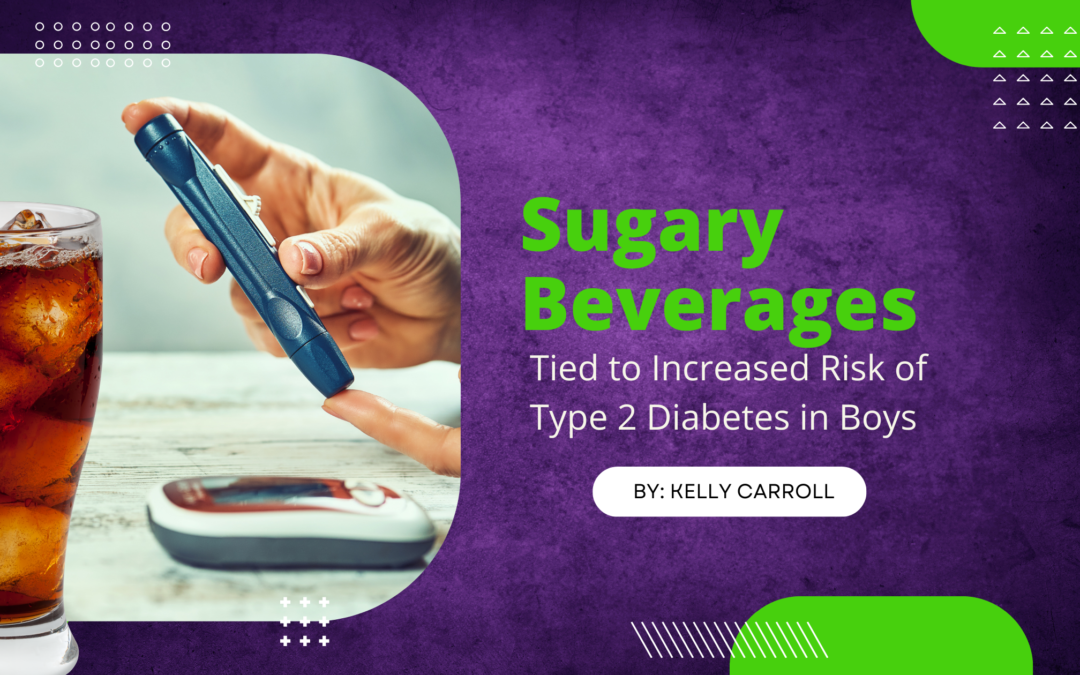Sugary Beverages Tied to Increased Risk of Type 2 Diabetes in Boys, Preliminary Study Finds
By: Kelly Carroll
Sugary drinks are the number one source of added sugar in U.S. kids’ diets, surpassing desserts, candy and breakfast cereals, according to the 2020-2025 Dietary Guidelines for Americans. Sugar-sweetened drinks—like sodas, fruit drinks and energy drinks—are often high in calories and are not necessary components of healthy diets.
New, preliminary research presented at the American Heart Association’s (AHA) EPI Lifestyle Scientific Sessions 2024 revealed a link between childhood and adolescent consumption of sugary beverages and Type 2 diabetes risk in boys. Every daily eight-ounce serving of sugary drinks boys had in childhood and adolescence was tied to a 34% increase in insulin resistance in late adolescence.
Insulin is a hormone that mediates the uptake of glucose, some sugar, into the body’s muscles, liver and fat. Insulin resistance prevents the body from removing glucose as well as it typically would, leading to the production of more insulin and raising the risk of prediabetes and Type 2 diabetes.
The study evaluated nearly 500 children in Massachusetts from birth until late adolescence. Researchers collected reports of drink consumption around ages three, eight, and 13 and took blood samples around age 17 to measure markers for Type 2 diabetes risk.
Sugary drink consumption in boys was also linked to other markers of heightened Type 2 diabetes risk. Each daily serving of sweetened beverages in childhood and adolescence was linked to an increase in fasting blood glucose levels (5.6 mg/dl increase) and hemoglobin A1C (0.12% increase). Boys’ consumption of fruit juice was also associated with increased hemoglobin A1C, a blood marker that indicates average blood glucose levels over the past two to three months.
The study’s lead researcher, Soren Harnois-Leblanc, a researcher at Harvard Pilgrim Health Care Institute and Harvard Medical School, explained in an email that the findings suggest that drinking sugary beverages and fruit juices may contribute to the development of Type 2 diabetes in kids, particularly in boys. She emphasized that prediabetes and Type 2 diabetes are “serious conditions related to childhood obesity” and have the potential to affect quality of life and lifespan. “Although the number of diagnosed new-onset type 2 diabetes remains low in children and adolescents…approximately 19% of American adolescents meet criteria for prediabetes in the United States,” she said.
Harnois-Leblanc said the research supports the message that kids and adolescents should avoid sugar-sweetened beverages and limit fruit juices. “Because sometimes individual food choices depend on many complex factors, we hope that our study and others will contribute to the development of public health policies that aim to improve access to better beverage and food options (water and whole fruits, for example), and to discourage sugary drinks and fruit juices consumption,” she said.
Penny Kris-Etherton, a nutrition professor at Penn State, emphasized that in the study, boys showed heightened markers of Type 2 diabetes risk at a young age, in late adolescence. She said in an AHA statement, “It is striking that many measures of Type 2 diabetes risk were increased in boys at such an early age.”
Although the research does not explain why the effects were seen more strongly in boys than in girls, Harnois-Leblanc hypothesized that biological and behavioral differences between boys and girls may contribute. “Males and females differ on several aspects regarding biology (such as their fat mass and insulin sensitivity levels) and behaviors (such as food choices, physical activity levels and sedentary behaviors) and it becomes even more evident as they progress into puberty. I believe that the associations observed mostly in boys could be attributable to these differences,” she explained.
The study had limitations. Because the research was observational, it found an association between childhood and adolescent sugary drink consumption and increased markers for Type 2 diabetes but could not conclude that sugary drink consumption caused the increase. The number of study participants was also small, which could have impacted the strength of the reported association.
Previous studies have shown negative consequences of sugary drink consumption. Children and adolescents who drink sugary beverages are at higher risk of obesity and tooth decay. Sugary drinks can also contribute to an increased risk of hypertension and heart disease.
Catharine Champagne, a professor of nutritional epidemiology at Louisiana State University, commented, “All in all, it is my belief that whole fruits are best…” in comparison to sugar-sweetened beverages and fruit juices. She added that fruit juice has more nutrients than sugar-sweetened beverages but should be moderated.
The AHA recommends that kids consume no more than eight ounces of sugary drinks per week and offers several practical tips to those who wish to cut down on sugary drinks. They suggest reducing sugary drink consumption slowly and gradually, drinking water over other beverages and trying homemade fruit smoothies as an alternative to sugar-sweetened beverages. Seltzer and sparkling water can help those who prefer carbonated drinks increase their water consumption.
AUTHOR BIO
Kelly is a freelance writer focusing on science and health topics. She earned a Ph.D. in Microbiology and Immunology from The University of Louisville. Kelly has published with The Borgen Project, The Turner Syndrome Foundation, and Study.com. A full writing portfolio is available at https://kellycarroll.space/portfolio.
OTHER WAYS TO CONNECT
We hope you found this information helpful! Do you have any thoughts? Please connect with us on Facebook and Instagram and let us know!
If you would like to learn more about upcoming events, sign up to receive our quarterly newsletter here.
Check out some of our other blog posts here, for tips and tricks for single parents, budget hacks, inspiration and more information about what we do here at SPARC Hope.

